 |
| The Sixteen, photo credit Arnaud Stephenson |
Thomas Tallis, John Tavener, Boris Ord, James MacMillan, Gabriel Jackson, William Byrd, Walter Lambe, Howard Skempton, Richard Pygott, Alec Roth, Peter Philips and Robert Parsons; The Sixteen, Harry Christophers; Cadogan Hall
Reviewed by Robert Hugill
on Dec 16 2015
Star rating: 5.0
Intelligent programming and fine singing in the Sixteen's Christmas programme
Christmas concerts are tricky things, how do you balance the interests of those who want something reflecting the season (including carols) against those who (like myself) are not interested in popular carols and want something meatier. For their concert The Virgin Mother and Child at the Cadogan Hall on 16 December 2015, Harry Christophers and The Sixteen programmed a series of works themed around the Virgin and the Christ child, mixing some lesser known 20th century and contemporary carols and Christmas pieces, with a traditional West Gallery carol and a group of more substantial 16th century works including one from the Eton Choirbook. The list of composers was varied, with music by Thomas Tallis, John Tavener, Boris Ord, James MacMillan, Gabriel Jackson, William Byrd, Walter Lambe, Howard Skempton, Richard Pygott, Alec Roth, Peter Philips and Robert Parsons. The concert is being toured, it debuted at Glyndebourne on 6 December and further dates are Royal Concert Hall, Nottingham (18 December), and Saffron Hall (20 December).
The concert opened with the plainsong
Puer natus est nobis which was followed immediately by the
Gloria from Tallis's mass based on the plainsong, presumed written for the Christmas after the marriage of Queen Mary and Philip of Spain as the court expected her pregnancy. The plainsong was sung alternim by high and low voices with everyone joining for the final verse. The
Gloria from Tallis's mass was sung in a beautifully restrained manner yet full of detail; the opening built from the single line to a lovely complexity of texture. There was a lovely relaxed feel to the performance, but still full of vibrant incident with a fine ebb and flow of voice in the polyphonic texture.
John Tavener's
The Lamb setting William Blake has become a classic, but welcome nonetheless. Christophers took it quite slowly, with every note beautifully place though perhaps it revelled in the textures a little too much with a touch of austerity being welcome.
Boris Ord's
Adam lay ybounden was written for King's College Cambridge where he was organist from 1929 to 1957 and here it receive a bright toned and finely focused performance.
Rejoice and be merry is from the tradition of West Gallery music and it was lovely to hear it included in the programme, sung alternim in unison with just the last verse harmonised. James MacMillan's
O radiant dawn sets one of the
O Antiphons and it has become a welcome staple in The Sixteen's repertoire. The choir gave a strong focus on the lovely words, whilst placing the harmony perfectly and singing with focused tone.
Gabriel Jackson's
The Christ-child was also written for King's College Cambridge, for the 2009 Festival of Nine Lessons and Carols. It sets text by GK Chesterton using rich harmonies which sounded almost bluesy at times. The choir brought a lovely radiance to the piece, especially the second lines of the verses, the first of which was
His hair is like light.
William Byrd's
Ave Maria is not one of his better known pieces. It is a small but lovely piece first published in the 1605
Gradualia though probably written in the 1590's for the private, clandestine services at Ingatestone Hall. Quite low key and surprisingly gentle, yet intense, it received a beautifully proportioned performance.
The first half concluded with the plainchant
Nesciens mater followed by Walter Lambe's motet from the Eton Choirbook based in the chant. Written in the 1400s, it uses a great deal of melisma and places different groups of voices in dialogue to create something rather wonderful.
The second half opened with Tallis's respond
Videte miraculum. (This is a work that I take a particular interest in as I wrote a companion setting of the same text for Alistair Dixon and Chapelle du Roi). The Sixteen's performance was nearly effortless with a lovely clarity to the fine high soprano line. Overall there was a great lightness of texture but combined with a nice intensity.
Adam lay ybounden reoccurred, this time in Howard Skempton's unhackneyed setting which gave us an interesting combination of textures with the fluid soprano part set against the steadier chanted lower parts.
Richard Pygott worked for Cardinal Wolsey before joining the Chapel Royal. His complex carol
Quid petis, O fili mixed a rather static Latin refrain sung tutti with fluid verses sung by a group of soloists (sometimes all four and sometimes in pairs). The result was a lovely combination of texture and gave us a piece of great charm.
A child is born in Bethlehem is another traditional piece, from the late 13th century and here sung with a lovely lilt. John Tavener's tiny
O, do not move was entirely magical. Alex Roth's
A song of the shepherds was written in 2013 to celebrate the quater-centenary of the metaphysical poet Richard Crashaw. It was a beautifully made piece, rather part-song like, with an appealing simplicity allied to great clarity in the word setting.
Peter Phillips
O beatum et sacrosanctum diem was one of his works published in Antwerp in 1612 but probably dating from earlier. Starting quite gently we had some lovely evocations of the trumpet and the sound of rejoicing leading to a lively conclusion. Finally Robert Parson's magically beautiful
Ave Maria, a lovely end to the concert.
Except it wasn't the end, we were treated to
Quem pastores laudavere and
Ding dong merrily on high to send us singing on our way.
Elsewhere on this blog:































%20in%20The%20Merry%20Widow.%20Credit%20Mihaela%20Bodlovic.%20(2).jpg)

%20in%20Trial%20by%20Jury.%20Credit%20Mihaela%20Bodlovic..jpg)


%20Britten%20Pears%20Arts%20(1).jpg)

.jpg)
